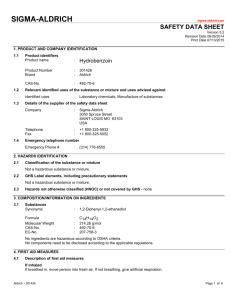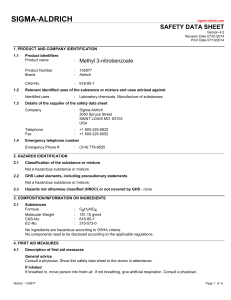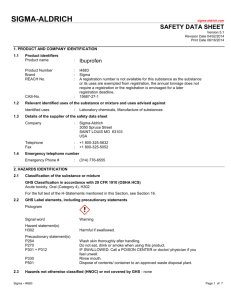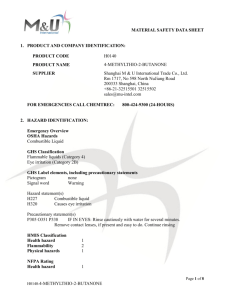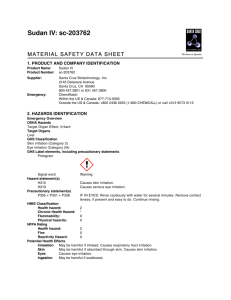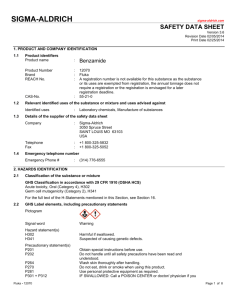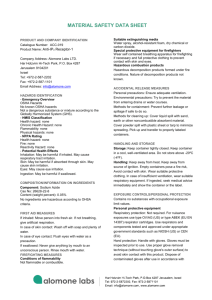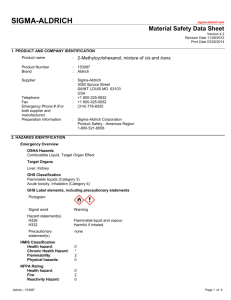MSDS PE
advertisement
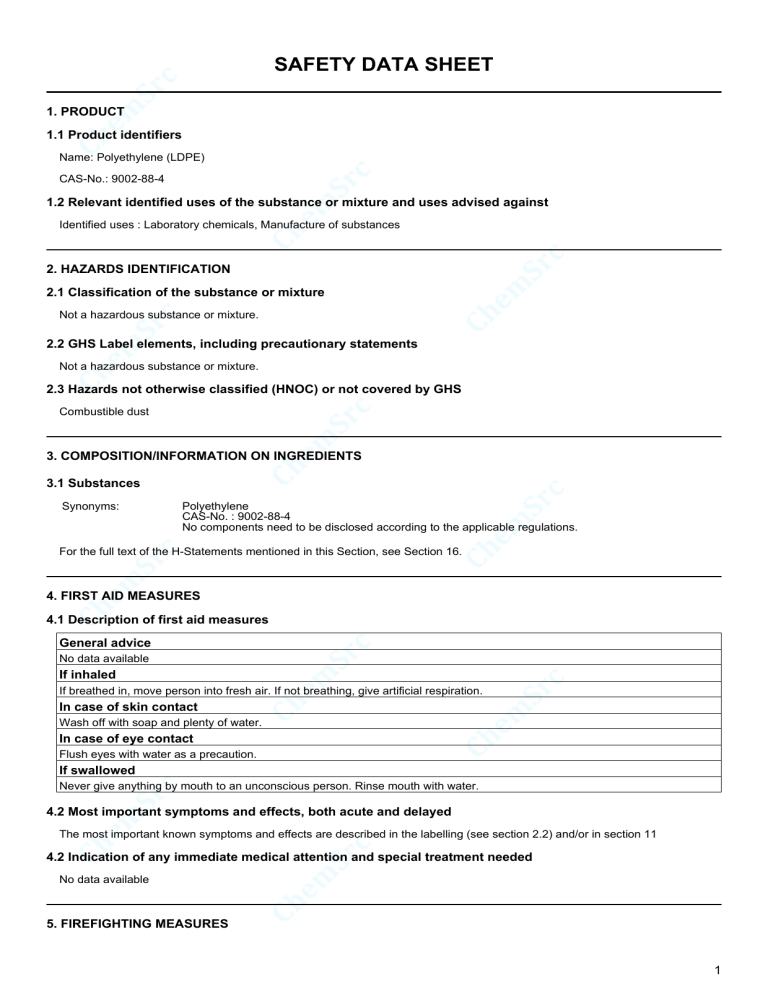
SAFETY DATA SHEET 1. PRODUCT 1.1 Product identifiers Name: Polyethylene (LDPE) CAS-No.: 9002-88-4 1.2 Relevant identified uses of the substance or mixture and uses advised against Identified uses : Laboratory chemicals, Manufacture of substances 2. HAZARDS IDENTIFICATION 2.1 Classification of the substance or mixture Not a hazardous substance or mixture. 2.2 GHS Label elements, including precautionary statements Not a hazardous substance or mixture. 2.3 Hazards not otherwise classified (HNOC) or not covered by GHS Combustible dust 3. COMPOSITION/INFORMATION ON INGREDIENTS 3.1 Substances Synonyms: Polyethylene CAS-No. : 9002-88-4 No components need to be disclosed according to the applicable regulations. For the full text of the H-Statements mentioned in this Section, see Section 16. 4. FIRST AID MEASURES 4.1 Description of first aid measures General advice No data available If inhaled If breathed in, move person into fresh air. If not breathing, give artificial respiration. In case of skin contact Wash off with soap and plenty of water. In case of eye contact Flush eyes with water as a precaution. If swallowed Never give anything by mouth to an unconscious person. Rinse mouth with water. 4.2 Most important symptoms and effects, both acute and delayed The most important known symptoms and effects are described in the labelling (see section 2.2) and/or in section 11 4.2 Indication of any immediate medical attention and special treatment needed No data available 5. FIREFIGHTING MEASURES 1 5.1 Extinguishing media Suitable extinguishing media Use water spray, alcohol-resistant foam, dry chemical or carbon dioxide. 5.2 Special hazards arising from the substance or mixture Carbon oxides 5.3 Advice for firefighters Wear self-contained breathing apparatus for firefighting if necessary. 5.4 Further information No data available 6. ACCIDENTAL RELEASE MEASURES 6.1 Personal precautions, protective equipment and emergency procedures Avoid dust formation. Avoid breathing vapours, mist or gas. For personal protection see section 8. 6.2 Environmental precautions Do not let product enter drains. 6.3 Methods and materials for containment and cleaning up Sweep up and shovel. Keep in suitable, closed containers for disposal. 6.4 Reference to other sections For disposal see section 13. 7. HANDLING AND STORAGE 7.1 Precautions for safe handling Provide appropriate exhaust ventilation at places where dust is formed. For precautions see section 2.2. 7.2 Conditions for safe storage, including any incompatibilities Keep container tightly closed in a dry and well-ventilated place. Recommended storage temperature -20 °C Keep in a dry place. 7.3 Specific end use(s) Apart from the uses mentioned in section 1.2 no other specific uses are stipulated 8. EXPOSURE CONTROLS/PERSONAL PROTECTION 8.1 Control parameters Components with workplace control parameters Contains no substances with occupational exposure limit values. 8.2 Exposure controls Appropriate engineering controls General industrial hygiene practice. Personal protective equipment 2 Eye/face protection Skin protection Use equipment for eye protection tested and approved under appropriate government standards such as NIOSH (US) or EN 166(EU). Handle with gloves. Gloves must be inspected prior to use. Use proper glove removal technique (without touching glove's outer surface) to avoid skin contact with this product. Dispose of contaminated gloves after use in accordance with applicable laws and good laboratory practices. Wash and dry hands. Body Choose body protection in relation to its type, to the concentration and amount of dangerous substances, and Protection to the specific work-place., The type of protective equipment must be selected according to the concentration and amount of the dangerous substance at the specific workplace. Respiratory Respiratory protection is not required. Where protection from nuisance levels of dusts are desired, use type protection N95 (US) or type P1 (EN 143) dust masks. Use respirators and components tested and approved under appropriate government standards such as NIOSH (US) or CEN (EU). Control of Do not let product enter drains. environmen tal exposure 9. PHYSICAL AND CHEMICAL PROPERTIES 9.1 Information on basic physical and chemical properties Appearance Odour Odour Threshold pH Melting point/freezing point Initial boiling point and boiling range Flash point Evaporation rate Flammability (solid, gas) Upper/lower flammability or explosive limits Vapour pressure Vapour density Relative density Water solubility Partition coefficient: n-octanol/water Auto-ignition temperature Decomposition temperature Viscosity Explosive properties Oxidizing properties Form: powder Colour: light grey No data available No data available No data available No data available No data available No data available No data available May form combustible dust concentrations in air No data available No data available No data available No data available No data available No data available No data available No data available No data available No data available No data available 9.2 Other safety information No data available 10. STABILITY AND REACTIVITY 10.1 Reactivity No data available 10.2 Chemical stability Stable under recommended storage conditions. 10.3 Possibility of hazardous reactions No data available 10.4 Conditions to avoid No data available 10.5 Incompatible materials 3 Strong oxidizing agents 10.6 Hazardous decomposition products Other decomposition products - No data available In the event of fire: see section 5 11. TOXICOLOGICAL INFORMATION 11.1 Information on toxicological effects Acute toxicity No data available Inhalation: No data available Dermal: No data available No data available Skin corrosion/irritation No data available Serious eye damage/eye irritation No data available Respiratory or skin sensitisation No data available Germ cell mutagenicity No data available Carcinogenicity Carcinogenicity - Rat - Implant Tumorigenic:Equivocal tumorigenic agent by RTECS criteria. Blood:Lymphomas including Hodgkin's disease. Tumorigenic:Tumors at site or application. IARC: 3 - Group 3: Not classifiable as to its carcinogenicity to humans (Ethene, homopolymer) ACGIH: No component of this product present at levels greater than or equal to 0.1% is identified as a carcinogen or potential carcinogen by ACGIH. NTP: No component of this product present at levels greater than or equal to 0.1% is identified as a known or anticipated carcinogen by NTP. OSHA: No component of this product present at levels greater than or equal to 0.1% is identified as a carcinogen or potential carcinogen by OSHA. Reproductive toxicity No data available No data available Specific target organ toxicity -single exposure No data available Specific target organ toxicity -repeated exposure No data available Aspiration hazard No data available Additional Information RTECS: Not available To the best of our knowledge, the chemical, physical, and toxicological properties have not been thoroughly investigated. 12. ECOLOGICAL INFORMATION 12.1 Toxicity No data available 12.2 Persistence and degradability No data available 12.3 Bioaccumulative potential No data available 12.4 Mobility in soil 4 No data available 12.5 Results of PBT and vPvB assessment PBT/vPvB assessment not available as chemical safety assessment not required/not conducted 12.6 Other adverse effects No data available 13. DISPOSAL CONSIDERATIONS 13.1 Waste treatment methods Product Offer surplus and non-recyclable solutions to a licensed disposal company. Contaminated packaging Dispose of as unused product. 14. TRANSPORT INFORMATION DOT (US) Not dangerous goods IMDG Not dangerous goods IATA Not dangerous goods 15. REGULATORY INFORMATION SARA 302 Components No chemicals in this material are subject to the reporting requirements of SARA Title III, Section 302. SARA 313 Components This material does not contain any chemical components with known CAS numbers that exceed the threshold (De Minimis) reporting levels established by SARA Title III, Section 313. SARA 311/312 Hazards No SARA Hazards Massachusetts Right To Know Components No components are subject to the Massachusetts Right to Know Act. Pennsylvania Right To Know Components Component CAS-No. Ethene, homopolymer 9002-88-4 Revision Date New Jersey Right To Know Components Component CAS-No. Ethene, homopolymer 9002-88-4 Revision Date California Prop. 65 Components This product does not contain any chemicals known to State of California to cause cancer, birth defects, or any other reproductive harm. 16. OTHER INFORMATION 5 HMIS Rating Health hazard: 0 Chronic Health Hazard: Flammability: 0 Physical Hazard 0 NFPA Rating Health hazard: 0 Fire Hazard: 0 Reactivity Hazard: 0 6
